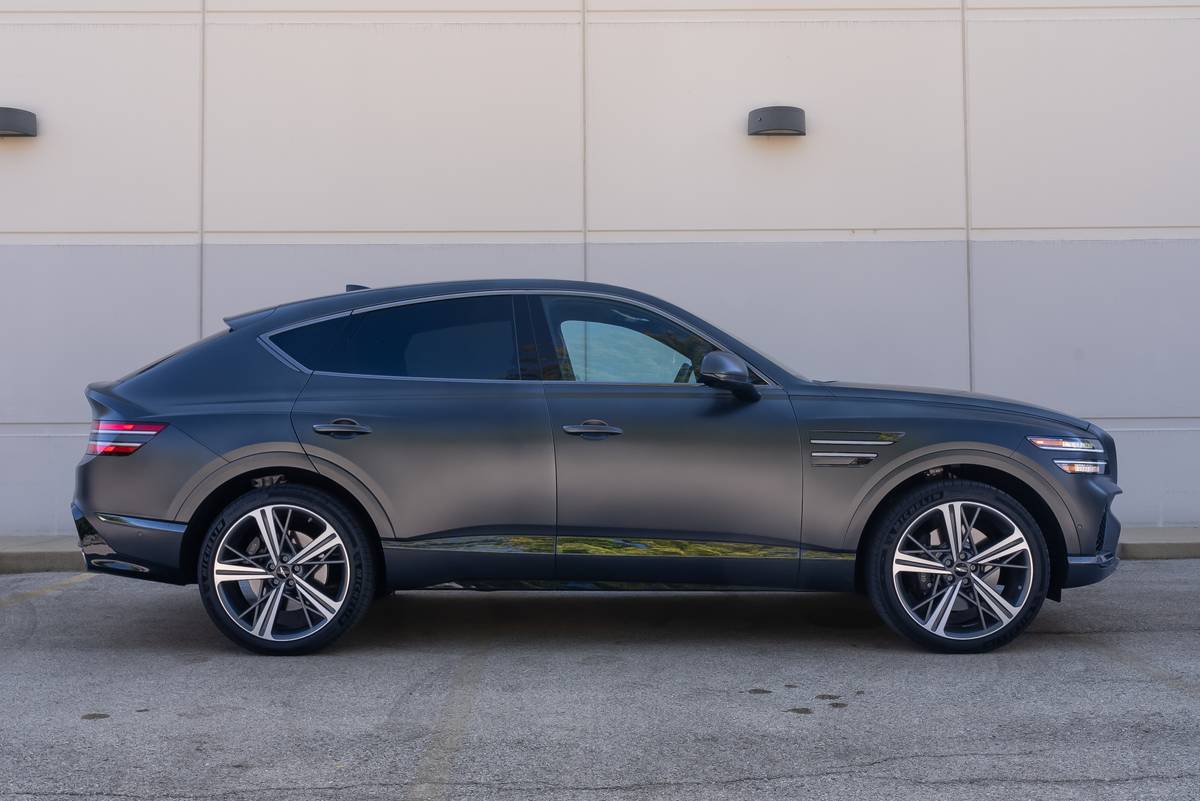Cincinnati.com's view
If these doggone deer keep helping me with my antilock brake tests, I’m going to have to put them on the payroll – or at least bring ’em a salt block. Once again I was cruising at modest speed over one of my favorite rural treks when a pair decided to assert their species’ prior claim to that stretch of road.
Happily for an animal lover who doesn’t even like venison, the brakes on the GMC Envoy XL were up to the task, allowing a quick swerve followed by a speedy recovery and a blank look from the dummies.
For a machine that approaches 5,000 pounds, the Envoy’s brake pedal was rather mushy, but the 4-wheel vented discs with which it communicates are of a size to get the job done nicely. In later, less spontaneous “panic” tests, I found stopping distances comfortingly short, at least with the vehicle carrying nearly as light a load as it ever will.
The Envoy XL is the stretch version of GMC’s midsize SUV. Its wheelbase, at 129 inches, is 16 inches greater than the standard Envoy’s. It eclipses its little brother by the same amount in terms of overall length, which in its case is 207.6 inches.
Principal competitors are the Acura MDX and Honda Pilot, which both, like the Envoy XL, have 7 sets of seatbelts, if you know what I mean, along with the less-boastful Ford Explorer/Mercury Mountaineer and Toyota’s new 4Runner.
GMC is closely affiliated with the Chevrolet division of GM, and if you check the specs you’ll see more than a passing resemblance to that marque’s TrailBlazer LT. They come off the same line, with GMC projecting a more rugged, trucker-oriented image, while the Chevy is a bit softer, more family-friendly, or so they’d have us believe. GMC is using the slogan “We are professional grade” these days and in this instance has been allowed to back it up with an optional V-8 engine, making the choice between the two harder than ever.
The Envoy can be had, in addition to the two sizes, in 2-wheel-drive or 4-wheel-drive form, and at three trim levels, base, XL and XE, in increasing order of poshness. The machine tested was an XL with the big motor and 2-wheel drive – a dirty trick when there’s 5 inches of snow on the ground, especially since it lacked even traction control. That and a locking rear differential are available at relatively modest cost, $175 and $270, respectively. At least traction lock should be standard on the 2WD versions, especially with the torquey V-8.
The standard powerplant is a 24-valve, double-overhead-cam inline 6 displacing 4.2 liters. Its 275 hp and 275 foot-pounds of torque would be quite adequate if all one did was haul people. But if you have the need to haul up to 7,200 pounds, you should be thinking either Mayflower or the $1,500 V-8 option.
The 8-holer displaces 5.3 liters – 327 cubic inches for nostalgia buffs. It’s a tried-and-true overhead-valve design with modern accoutrements like fuel injection and platinum spark plugs.
It raises the ante on horsepower almost insignificantly, to 290 (at 5,200 rpm). But with a truck or SUV in particular, torque is the thing, and the V-8 provides 325 foot-pounds thereof, a meaningful 18 percent bump. It’s good to see, in this time of oil uncertainty, that either engine works for regular, 87-octane fuel, though they do gulp it rather hoggishly.
The EPA estimates for the 2WD XL with V-8 are 15 mpg city, 19 highway. I measured 16.2 over my rural course, with a little bit of freeway flying thrown in. Naturally, the 4WD versions would be a bit thirstier because of mechanical losses.
The only transmission available on an Envoy is a four-speed Hydra-Matic, and who could ask for anything more? It shifted with silken precision and no hesitation, and, with that much torque available, a five-speed would be nice, but is not mandatory. In top gear, with the thriftier 3.42:1 axle, I measured about 30 mph per 1,000 rpm in overdrive fourth. A 3.73:1 can be d with the V-8 for extra grunt (but it’ll cost you in fuel economy), and a 4.10:1 with the 6-cylinder. By the time you do the latter, you might be better off with the V-8. Besides, the V-8 when pushed makes delicious, basso profundo noises some of us trucker types enjoy.
The Envoy is nicely styled, without superfluous froo-froo or unnecessary bending of sheetmetal. Even in XL form, it looks rather sleek, not hulking, though it is 6 feet, 3.5 inches high.
The interior, even at XL level, is a surprise. Though it lacks the leather and wood accents found in the XE, it is a surprisingly pleasant environment with its upscale cloth seats and brushed-nickel accents used with some discretion throughout the cabin. Volumetrically, the Envoy has 22 cubic feet of gear space behind the third row – that’s 50 percent more than you’d find in the trunk of a medium-sized car. Drop the third row and that jumps to 61 c.f.; fold the second row, too, and you have a 100-c.f. cavern, spread out over a bit more than 7 feet.
The operating controls for air conditioner and radio are large, well-marked and sensibly placed fairly high up in the middle of the dash, and canted ever so slightly toward the driver.
The instruments – the usual four plus oil pressure and voltage – are well situated and quite legible. And the seatbelts, often a thorny subject on GM products, were for once reasonably easy to use.
The Envoy handled well, feeling smaller than it is. Steering was reasonably quick and well-weighted. Turning radius of 41-feet plus, not unexpected with such a wheelbase, argues against taking the Envoy XL to shopping mall lots at Christmas time.
Ride quality, with only me aboard, was marginal for the class. This may be a function of the included heavy-duty trailering group, and would only improve with added burdens. Still, if you don’t mean to do a lot of serious hauling, you might do better looking at more car-like alternatives.
The Envoy talks to the road through 245/65 tires on 17-inch alloy rims. They were fairly grippy even in snow.
The Transportation Department has not crash-tested an Envoy yet (they were introduced last year in their present form). But the Insurance Institute for Highway Safety did crash a standard-wheelbase Envoy into an offset barrier at 40 mph and rated its occupant protection “marginal,” mainly because the dummy driver’s head hit the B pillar and his right leg was severely injured. It’s a somewhat precarious proposition to extrapolate those results to the larger versions, but it is indicative of what would happen in that specific kind of crash. The Envoy XL is assembled in Moraine, Ohio and Oklahoma City.
Base price on the 2WD Envoy XL is $30,370. The SLE package costs $1,450 and includes a power driver’s seat, lighted vanity mirrors, electrochromic rearview mirror inside and heated, power mirrors outside, and luggage rack cross bars. A radio upgrade and in terior theft alarm added $190, polished aluminum wheels $495. Total, with freight, was $34,630. That’s manufacturer’s suggested. Edmunds.com pricing surveys indicate you might be able to haggle about $2,500 off that price. At the nominal price, payments would be $696, assuming 20 percent down, 10 percent interest and 48 coupons.
Latest news


10 Biggest News Stories of the Week: Jeep Wrangler Rides on Audi E-Tron GT, Chrysler Pacifica Hybrid

